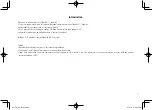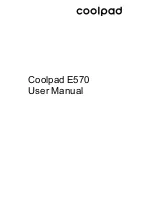
The ratings are not guarantees. Results will vary depending on the user’s hearing device and hearing
loss. If your hearing device happens to be vulnerable to interference, you may not be able to use a rated
mobile device successfully. Trying out the mobile device with your hearing device is the best way to
evaluate it for your personal needs.
M‑Ratings: Wireless mobile devices rated M3 or M4 meet FCC requirements and are likely to generate
less interference to hearing devices than mobile devices that are not labeled. M4 is the better/higher of
the two ratings. M-ratings refer to enabling acoustic coupling with hearing aids that do not operate in
telecoil mode.
T‑Ratings: Mobile devices rated T3 or T4 meet FCC requirements and are likely to generate less
interference to hearing devices than mobile devices that are not labeled. T4 is the better/higher of the
two ratings. T-ratings refer to enabling inductive coupling with hearing aids operating in telecoil mode.
Hearing devices may also be rated. Your hearing aid manufacturer or hearing health professional may
help you find this rating. Higher ratings mean that the hearing device is relatively immune to interference
noise.
Under the current industry standard, American National Standards Institute (ANSI) C63.19, the hearing
aid and wireless mobile device rating values are added together to indicate how usable they are together.
For example, if a hearing aid meets the M2 level rating and the wireless mobile device meets the M3
level rating, the sum of the two values equals M5.
Under the standard, this should provide the hearing aid user with normal use while using the hearing aid
with the particular wireless mobile device. A sum of 6 or more would indicate excellent performance.
However, these are not guarantees that all users will be satisfied. T ratings work similarly.
M3 + M2 = 5
T3 + T2 = 5
The HAC rating and measurement procedure are described in the American National Standards Institute
(ANSI) C63.19 standard.
Other Medical Devices
If you use any other personal medical devices, consult the manufacturer of your device to determine if
it is adequately shielded from external RF energy. Your physician may be able to assist you in obtaining
this information. Switch your mobile device off in health care facilities when any regulations posted in
these areas instruct you to do so. Hospitals or health care facilities may be using equipment that could
be sensitive to external RF energy.
Vehicles
RF signals may affect improperly installed or inadequately shielded electronic systems in motor
vehicles. Check with the manufacturer or its representative regarding your vehicle before using your
mobile device in a motor vehicle. You should also consult the manufacturer of any equipment that has
been added to your vehicle.
Posted Facilities
Switch your mobile device off in any facility where posted notices require you to do so.
Potentially Explosive Environments
Switch your mobile device off when in any area with a potentially explosive atmosphere and obey all
signs and instructions. Sparks in such areas could cause an explosion or fire resulting in bodily injury or
even death. Users are advised to switch the mobile device off while at a refueling point (service station).
Users are reminded of the need to observe restrictions on the use of radio equipment in fuel depots
(fuel storage and distribution areas), chemical plants, or where blasting operations are in progress.
Areas with a potentially explosive atmosphere are often, but not always, clearly marked. They include
below deck on boats, chemical transfer or storage facilities, vehicles using liquefied petroleum gas
(such as propane or butane), areas where the air contains chemicals or particles, such as grain, dust, or
metal powders, and any other area where you would normally be advised to turn off your vehicle engine.
Vehicles using liquefied petroleum gas (such as propane or butane) must comply with the National
Fire Protection Standard (NFPA-58). For a copy of this standard, contact the National Fire Protection
Association.
When your Device is Wet
Do not turn on your device if it is wet. If your device is already on, turn it off and remove the battery
immediately (if the device will not turn off or you cannot remove the battery, leave it as-is). Then, dry the
device with a towel and take it to a service center.
FCC Hearing Aid Compatibility (HAC) Regulations for Wireless Devices
The U.S. Federal Communications Commission (FCC) has established requirements for digital wireless
mobile devices to be compatible with hearing aids and other assistive hearing devices.
When individuals employing some assistive hearing devices (hearing aids and cochlear implants) use
wireless mobile devices, they may detect a buzzing, humming, or whining noise. Some hearing devices
are more immune than others to this interference noise, and mobile devices also vary in the amount of
interference they generate.
The wireless telephone industry has developed a rating system for wireless mobile devices to assist
hearing device users find mobile devices that may be compatible with their hearing devices. Not all
mobile devices have been rated. Mobile devices that are rated have the rating on their box or a label
located on the box.




































